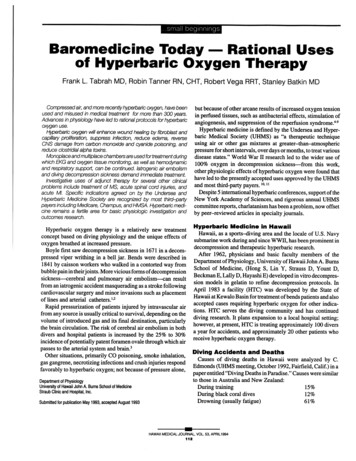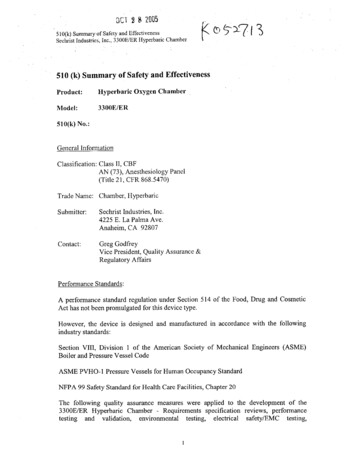
Transcription
Baromedicine Today - Rational Usesof Hyperbaric Oxygen TherapyFrankL. Tabrah MD, Robin Tanner RN, CHT, Robert Vega RRT, Stanley Batkin MDCompressed air, and more recently hyperbaric oxygen, have beenused and misused in medical treatment for more than 300 years.Advances in physiology have led to rational protocols for hyperbaricoxygen use.Hyperbaric oxygen will enhance wound healing by fibroblast andcapillary proliferation, suppress infection, reduce edema, reverseCNS damage from carbon monoxide and cyanide poisoning, andreduce clostridial alpha toxins.Manop/ace and multip/ace chambers are used for treatment durinflwhich EKG and oxygen tissue monitoring, as well as hemodynamcand respiratory support, can be continued. Iatrogenic air embolismand diving decompression sickness demand immediate treatrr: nt.Investigative uses of adjunct therapy for several other cltntcalproblems include treatment of MS, acute spinal cord injuries, andacute MI. Specific indications agreed on by the Undersea andHyperbaric Medicine Society are recognized by most thir;:J--partypayers including Medicare, Champus, and HMSA. Hyperbanc medtcine remains a fertile area for basic physiologic investigation andoutcomes research.but because of other arcane results of increased oxygen tensionin perfused tissues, such as antibacterial effects, stimulation ofangiogenesis, and suppression of the reperfusion syndrome."-9Hyperbaric medicine is defmed by the Undersea and Hyperbaric Medical Society (UHMS) as "a therapeutic techniqueusing air or other gas mixtures at greater-than-atmosphericpressure for short intervals, over days or months, to treat variousdisease states." World War II research led to the wider use of100% oxygen in decompression sickness-from this work,other physiologic effects of hyperbaric oxygen were found thathave led to the presently accepted uses approved by the UHMSand most third-party payers. 10 11Despite 5 international hyperbaric conferences, support of theNew York Academy of Sciences, and rigorous annual UHMScommittee reports, charlatanism has been a problem, now offsetby peer-reviewed articles in specialty journals.Hyperbaric Medicine in HawaiiHyperbaric oxygen therapy is a relatively new treatmentHawaii, as a sports-diving area and the locale of U.S. Navyconcept based on diving physiology and the unique effects ofsubmarine work during and since WWII, has been prominent inoxygen breathed at increased pressure.decompression and thera{ eutic hyperbaric research.Boyle first saw decompression sickness in 1671 in a decomAfter 1962, physicians and basic faculty members of thepressed viper writhing in a bell jar. Bends were described inDepartment of Physiology, University of Hawaii John A. Burns1841 by caisson workers who walked in a contorted way fromSchool of Medicine, (Hong S, Lin Y, Strauss D, Yount D,bubble pain in their joints. More vicious forms of decompressionBeckman E, Lally D, Hayashi E) developed in vitro decompressickness-cerebral and pulmonary air embolism-can resultsion models in gelatin to refine decompression protocols. Infrom an iatrogenic accident masquerading as a stroke followingApril 1983 a facility (HTC) was developed by the State ofcardiovascular surgery and minor invasions such as placementHawaii at Kewalo Basin for treatment of bends patients and also12of lines and arterial catheters. accepted cases requiring hyperbaric oxygen for other indicaRapid pressurization of patients injured by intravascular airtions. HTC serves the diving community and has continuedfrom any source is usually critical to survival, depending on thediving research. It plans expansion to a local hospital setting;volume of introduced gas and its final destination, particularlyhowever, at present, HTC is treating approximately 100 diversthe brain circulation. The risk of cerebral air embolism in botha year for accidents, and approximately 20 other patients whodivers and hospital patients is increased by the 25% to 30%receive hyperbaric oxygen therapy.incidence of potentially patent foramen ovale through which airpasses to the arterial system and brain. 3Diving Accidents and DeathsOther situations, primarily CO poisoning, smoke inhalation,Causes of diving deaths in Hawaii were analyzed by C.gas gangrene, necrotizing infections and crush injuries respondEdmonds (UHMS meeting, October 1992, Fairfield, Calif.) in afavorably to hyperbaric oxygen; not because of pressure alone,paper entitled "Diving Deaths in Paradise." Causes were similarto those in Australia and New Zealand:Department of Physiology.University of Hawaii John A Bums School of Med1c1neDuring training15%Straub Clinic and Hospital, Inc.During black coral dives12%Drowning (usually fatigue)61%Submitted for publication May 1993, accepted August1993-HAWAII MEDICAL JOURNAL, VOL 53, APRIL 1994112
BarotraumaCardiac deathsDecompression sickness15%9%5%Human factors such as lack of judgment and preparationcontributed to 44% of the deaths, equipment problems, 40% andsea conditions, 56%. In the U.S. as a whole Diver's AlertNetwork (DAN), which analyses most sports-diving accidents,reports an overall diving accident rate of 0.2 %, based on 80,000dives. In 1989, 32% of all injured divers were using divecomputers, 68% theoretically were using dive tables, probablypoorly if at all. Despite excellent local opportunities for training,many Hawaiian sports divers largely ignore decompressionlimits in a macho style that invites bends and in the long-term,osteonecrosis. Compounding this problem is the prevalence ofyo-yo diving-multiple dives daily with very short surfacebreaks; neither dive tables nor computers are designed to manage more than 2 or 3 dives a day. Nor does any present computeror table address the cumulative gas load of many successive daysof multiple dives, often as many as 6 or more daily. Like gravity,the fundamental gas laws cannot be ignored.In June 1989, a hyperbaric center was opened at Straub Clinicand Hospital and at present it accepts only patients requiringtreatment for problems other than diving accidents. Since opening, more than 200 patients have received treatment coursesaveraging 30 ninety-minute compressions at 2 to 3 atmospheresof oxygen over 30 days. Indications for treatment were:21%Preparation for plastic procedure15%infectiontissueNecrotizing soft15%Peripheral arterial insufficiency, acute15%Diabetic foot ulcers12%Radionecrosis (bone or soft tissue)21%OtherBecause of the very high incidence of diabetes and its vascularcomplications among Hawaiians (nearly 5 times the rate forCaucasians) leading to refractory osteomyelitis and limb loss, aretrospective and prospective study of outcomes with and without adjunctive use of hyperbaric oxygen in refractoryosteomyelitis has begun with Straub Foundation support.Recent wider understanding and acceptance by Hawaii physicians of hyperbaric medicine following residency and CMEtraining at baromedicine centers has greatly increased inpatientand outpatient referrals to Hawaii's 2 hyperbaric treatment sites.Physiology and Clinical ApplicationsWhen breathing air under normal conditions, 98.4% of theavailable oxygen is bound to hemoglobin. The remaining portion is dissolved in plasma. Because hemoglobin is 97% saturated by inspired air, changing to a breathing source of straightoxygen changes hemoglobin-delivered oxygen by only 3%. Theremaining oxygen will be dissolved in the plasma. For eachadditional atmosphere of pressure, the amount of additionaloxygen dissolved in plasma is 2.3 vol%. Thus at about 3 ATA (3atmospheres, absolute pressure, the maximum working pressurefor most HBO treatment) more than 6 vol% is carried in theplasma. Because the tissue requirement for oxygen is roughly 5vol%, enough oxygen is carried in the plasma alone to fullysupport life. Normal peripheral tissue oxygen tensions measured through the skin approximate 40 mm Hg; at treatmentlevels, this can be raised to over 2200 mm Hg, with remarkablelocal tissue effects.Fibroblastic proliferation, collagen production, andneovascularization with resulting growth of granulation tissueoccur in the presence of intermittent tissue hyperoxygenation.Under oxygen pressure, the diffusion distance of oxygen increases 2 to 3 times, which assists in the delivery of oxygen tohypoxic areas in healing wounds, enhancing the various elements of healing, particularly angiogenesis, of great interest inradiation necrosis of bone and soft tissues.Months or years after radiation for malignancy, a few patientsdevelop disabling clinical disease of soft tissue or necrotic bonethat can be progressive, painful, and potentially fatal due totissue breakdown and loss of protective barriers. 12·13 14 Evenpatients who do not develop such overt clinical disease can haveradiation tissue damage which can be progressive and coulddevelop later into overt disease with increased risk of infection,wound dehiscence, tissue loss, and graft loss when surgeries arerequired in irradiated tissues.l5,16,17,lsThe pathophysiology includes endarteritis, inflammation, fibrosis, and hypoxia-clinical states include radiated bowelsyndrome, radiation mucositis, soft tissue radionecrosis, andlaryngeal radionecrosis. Compromised tissues invite secondaryinfections, gangrenous bowel, cellulitis, fascitis, and hemorrhagic cystitis. Hyperbaric oxygen has been successful in management of the cystitis and other soft tissue problems involvinginfection and restoration of adequate vascularity. 19·20·21 Casemanagement includes both pre- and post-operative treatment.In the presence of bacterial infection the phagocytic leukocyteis an important defense. Although the ingestion of bacteria canbe an anaerobic function, effective killing requires oxygen as asubstrate. Increased levels of molecular oxygen are convertedby the leukocyte into high energy radicals (the superoxide freeradical, hydrogen peroxide, and the hydroxyl radical), all toxicto bacteria. 22 Since active infection in a rabbit tibia by Staphylococcus aureus has been shown by Mader23 to reduce tissueoxygen levels to half that necessary for leukocytic function, andaddition of oxygen by hyperbaric pressure effectively restoresthe killing action, a rationale exists for adjunct use of hyperbaricoxygen in refractory infections of bone, and in overwhelmingsoft tissue infections. The combination of adequate debridement,antibiotics, and hyperbaric treatment are most effective in preventing recurrence. The dramatic effect ofhyperbaric oxygen onclostridial and other anaerobic infections is well establishedclinically, although the exact mechanism of suppression ofalpha toxins is not understood.24Another interesting effect of increased oxygen tension is a20% to 50% reduction of blood flow, primarily through arterialvasoconstriction, without reduction in oxygen availability because of the greatly increased amount of oxygen carried in-HAWAII MEDICAL JOURNAL. VOL. 53, APRIL 1994113
solution.25 This vasoconstriction is reported to be of clinicalvalue in reducing edema, tissue loss, and scarring in bumpatients,26 and prompt reduction of compartment pressures incompartment syndrome. 27Recent interest in the reperfusion syndrome has ranged acrossmany tissues, including brain, heart, and skeletal muscle. In vivohistologic and chemical studies by Zamboni28 show that in ratmuscle, ischemia causes "sticking and rolling" of neutrophils onvenule walls accompanied by the release of thromboxane andother vasoactive substances into the interstitium, causing vasoconstriction of adjacent arterioles and further ischemia. Thisprocess appears to be related to superoxide production by theneutrophils and action can be blocked by high oxygen tensions.In the experimental model, exposure to hyperbaric oxygenwithin 12 hours of reperfusion altered the usual free-radicalpathway to produce harmless hyperperoxyl radicals that reactwith lipid radicals to form nonradical products, probably reducing lipid peroxidation. 29 Further clinical trials of the use ofhyperbaric oxygen to reverse the baleful microvascular eventsthat accompany reperfusion are necessary. Present interest centers around CVA, cord injuries, crush injury, compartmentsyndrome, and acute MI.In unpublished data, Youngblood and others30 report promptrelief of migraine headache and its associated symptoms in morethan 90% of patients within minutes after compression, probably on the basis of vasoconstriction. Cerebral edema of variousorigins has been considered an indication for hyperbaric oxygentherapy, but current clinical information does not support thisuse.In carbon monoxide and cyanide poisoning, past teaching hasstressed the importance ofloss of oxygen transport by hemoglobin linkage, leading to CNS anoxia, collapse, and death. Recentresearch indicates the loss of oxygen transport is of little significance compared with the direct effect of CO orCN on CNS cells,which primarily impairs mitochondrial cytochrome by bindingto cytochrome c oxidase.33 Also, lipid peroxidation damageoccurs; both insults are reversible by use of hyperbaric oxygen,but not with the use of oxygen at ambient pressure. 32If CO poisoning is suspected, carboxyhemoglobin determinations are of little use, since low levels can be found in patientswith already serious brain damage from direct CO/cytochromec oxidase binding. High carboxyhemoglobin levels are simplyconfirmatory of CO exposure and are not even of much prognostic use. Careful clinical evaluation, particularly of cognitive andneurologic function, is essential to making an accurate diagnosisof CO poisoning and selecting a choice of therapy. If there is anydoubt about the degree of CO or CN exposure, hyperbaricoxygen treatment is essential in reducing the very real risks oflate sequelae that often result in permanent cognitive or psychiatric disorders.Although hyperbaric oxygen does not in any way replaceconventional management, several researchers have found it tobe an important adjunctive measure in treatment of thermalbums. Its be
